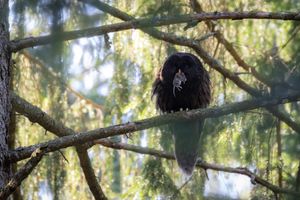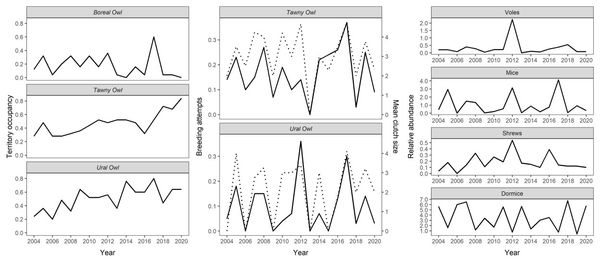 LINKED PAPER
LINKED PAPER
Differential responses of coexisting owls to annual small mammal population fluctuations in temperate mixed forest. Ratajc, U., Breskvar, M., Džeroski, S. & Vrezec, A. 2021 Ibis. doi: 10.1111/ibi.13029 VIEW
Montane temperate forests in Central and Southern Europe host diverse small mammal assemblages, consisting of a wide range of species with different traits, including herbivorous voles Cricetidae, insectivorous shrews Soricidae, omnivorous mice Muridae and dormice Gliridae (Kryštufek & Griffiths 1999). Individual species abundances can fluctuate with high amplitude between years (Zárybnická et al. 2015), to which small-mammal eating predators may respond in different ways. Fluctuations of small mammal populations in correlation with owl predators are still poorly understood in Dinaric forests. Therefore, the aim of our research was to identify adaptive changes in territory occupancy and breeding activity of the three coexisting owl species in these temperate forests: Boreal Owl Aegolius funereus, Tawny Owl Strix aluco and Ural Owl Strix uralensis (Vrezec 2003, Vrezec & Tome 2004 a, b). We conducted a long-term study (2004 – 2020) in montane (300-1100 m asl) mixed Beech and Silver Fir Forest in the northern Dinaric Alps (central Slovenia). We used machine learning methods (predictive clustering trees and feature importance estimation methods) to analyse monitoring data and identify relationships between abundance of small mammal groups on the one hand and owl territory occupancy, breeding attempts and clutch size on the other. We found that populations of coexisting owl species respond to changes in small mammal abundances at different stages and with different magnitudes, reflecting species-specific life histories and survival strategies.

Figure 1 Yellow-necked Mice Apodemus flavicollis and Bank Voles Clethrionomys glareolus in prey storage in the Tawny Owl’s Strix aluco nest during the breeding season © Al Vrezec.
Based on available breeding diet data from the nest boxes, mammalian prey dominated and the Yellow-necked Mouse Apodemus flavicollis and Bank Vole Clethrionomys glareolus made up the bulk of the diet in all three owl species (Figure 1). The third most frequent prey was the Edible Dormouse Glis glis. We found that populations of mice, voles and shrews increase in abundance irregularly, every two to five years, which has already been suggested regarding Central European temperate forests (Zárybnická et al. 2015). Dormice population fluctuations pattern differed from the other small mammal groups, usually peaking when abundance of other small mammals was low (Figure 2). Mice and voles predominated over shrews and dormice in temperate mixed forests.

Figure 2 Population dynamics of owls and small mammals on Mt. Krim from 2004 to 2020. The relative abundance of owls is given as the number of active territories per survey point (territory occupancy) and as the proportion of occupied nest boxes (breeding attempts). The dotted line represents between-year changes in mean clutch size. The relative abundance of voles, mice and shrews is given as the number of individuals trapped per 10 trap-nights, and the relative abundance of dormice is given as the number of vocalising individuals per survey point.
Our results indicate that the dominant species in the small mammal assemblage, i.e., the Yellow-necked Mouse, has a key role in determining predator populations and their breeding performance. The role of other small mammal species in the assemblage is secondary to owl predators, allowing them to compensate for food requirements in periods of low population sizes of the dominant prey species. However, the efficiency of utilisation of secondary prey in low years varies greatly among owls. This results in significant declines in territory occupancy (Boreal Owl) or breeding attempt rate and clutch size (Ural Owl), but less severe declines in species that are more flexible in prey selection (Tawny Owl).
Our results suggest that the co-dynamics between owls and prey in temperate mixed forests distinctly differs from those in boreal forests (Newton 2002). The majority of the Boreal and Ural Owl populations in Europe are confined to the boreal zone, whereas the main distribution of the Tawny Owl in Europe is in the temperate zone (Huntley et al. 2007). Therefore, it is not surprising that we found higher sensitivity to small mammal fluctuations in boreal zone owl species (Boreal and Ural Owls), which reach their southern distribution limit in the Dinaric Alps, while temperate zone species (Tawny Owl) seems to be less affected. In years of prey-shortage, the Boreal Owl was found to presumably abandon its territories, the Ural Owl suppressed breeding waiting in the territory for better years, and the Tawny Owl sustained its breeding activity by shifting prey selection (Figure 3).

Figure 3 Graphical abstract of species-specific responses of forest owls to prey shortages in Dinaric Beech and Silver Fir montane forests of Southern Europe.
References
Huntley, B., Green, R.E., Collingham, Y.C. & Willis, S.G. 2007. A climatic atlas of European breeding birds. Lynx Edicions, Barcelona.
Kryštufek, B. & Griffiths, H.I. 1999. Mediterranean v. continental small mammal communities and the environmental degradation of the Dinaric Alps. Journal of Biogeography 26: 167-177. VIEW
Newton, I. 2002. Population ecology in Holarctic owls. In: Ecology and conservation of owls (I. Newton, R. Kavanagh, J. Olson, & I. R. Taylor, eds), pp. 3–29. CSIRO Publishing, Collingwood, Victoria.
Vrezec, A. 2003. Breeding density and altitudinal distribution of the Ural, Tawny, and Boreal owls in North Dinaric Alps (Central Slovenia). Journal of Raptor Research 37: 55-62. VIEW
Vrezec, A. & Tome, D. 2004a. Habitat selection and patterns of distribution in a hierarchic forest owl guild. Ornis Fennica 81: 109-118. VIEW
Vrezec, A. & Tome, D. 2004b. Altitudinal segregation between Ural Owl Strix uralensis and Tawny Owl S. aluco: evidence for competitive exclusion in raptorial birds. Bird Study 51: 264-269. VIEW
Zárybnická, M., Sedláček, O., Salo, P., Šťastný, K. & Korpimäki, E. 2015. Reproductive responses of temperate and boreal Tengmalm’s Owl Aegolius funereus populations to spatial and temporal variation in prey availability. Ibis 157: 369-383. VIEW
Top right: Melanistic Ural Owl Strix uralensis with Bank Vole Clethrionomys glareolus. In temperate forests they specialise on mice and voles, with dormice as alternative prey © Božo Bradaškja.
If you want to write about your research in #theBOUblog, then please see here.



